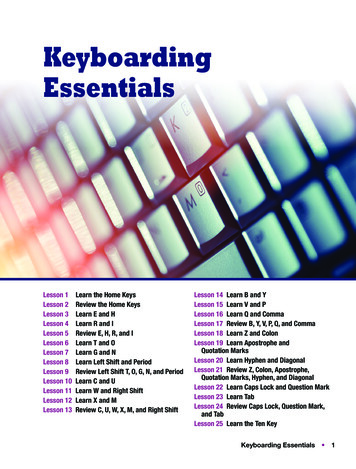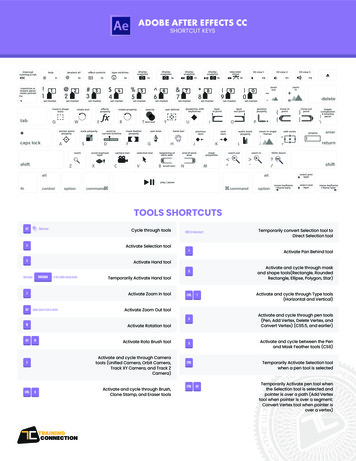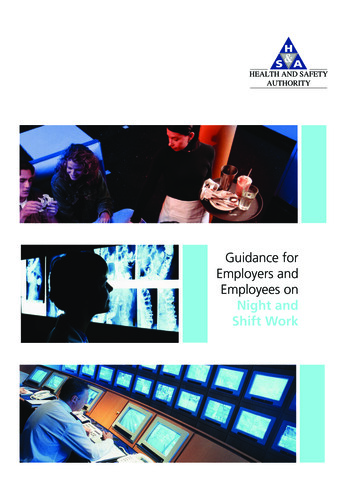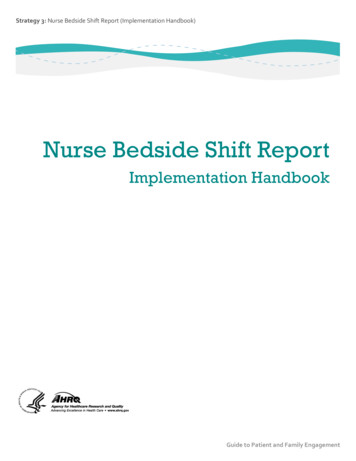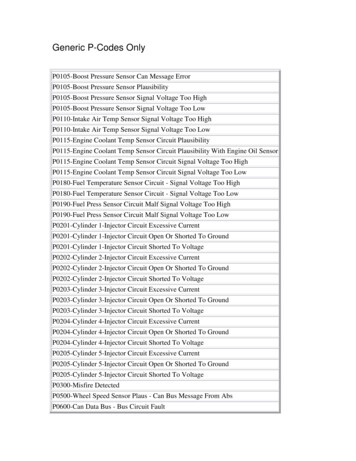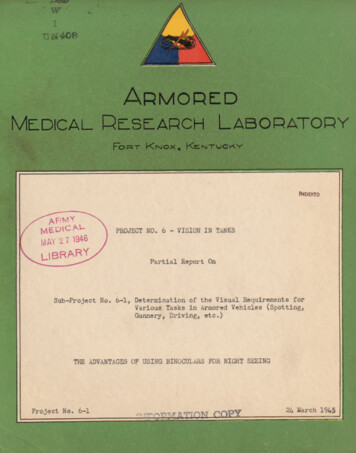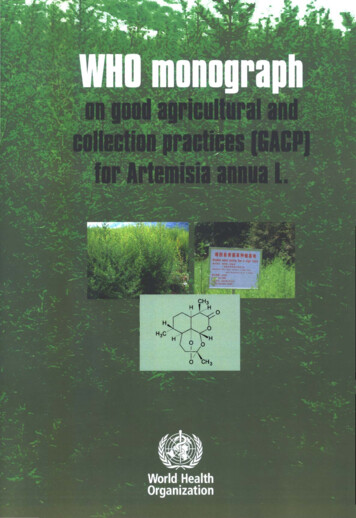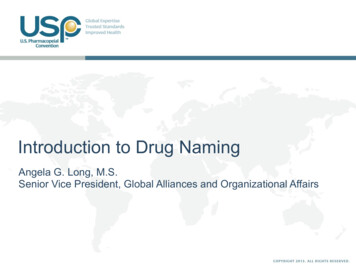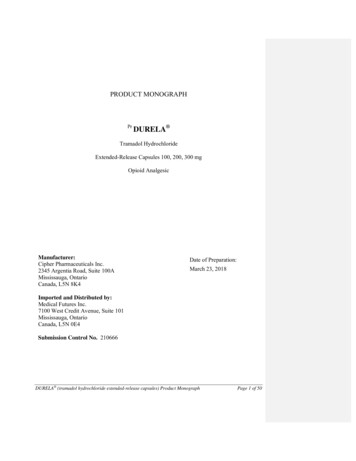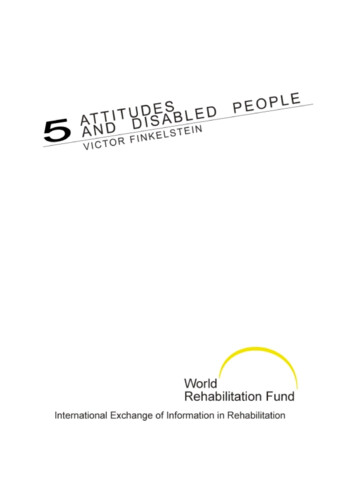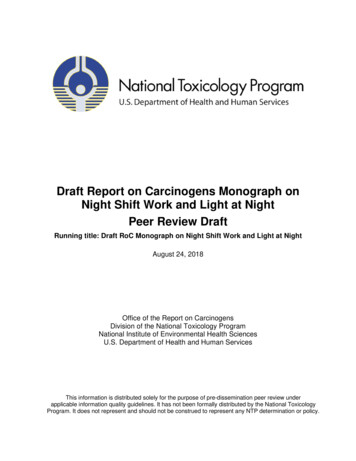
Transcription
Draft Report on Carcinogens Monograph onNight Shift Work and Light at NightPeer Review DraftRunning title: Draft RoC Monograph on Night Shift Work and Light at NightAugust 24, 2018Office of the Report on CarcinogensDivision of the National Toxicology ProgramNational Institute of Environmental Health SciencesU.S. Department of Health and Human ServicesThis information is distributed solely for the purpose of pre-dissemination peer review underapplicable information quality guidelines. It has not been formally distributed by the National ToxicologyProgram. It does not represent and should not be construed to represent any NTP determination or policy.
Draft RoC Monograph on Night Shift Work and Light at Night8/24/18ForewordThe National Toxicology Program (NTP) is an interagency program within the Public HealthService (PHS) of the Department of Health and Human Services (HHS) and is headquartered atthe National Institute of Environmental Health Sciences of the National Institutes of Health(NIEHS/NIH). Three agencies contribute resources to the program: NIEHS/NIH, the NationalInstitute for Occupational Safety and Health of the Centers for Disease Control and Prevention(NIOSH/CDC), and the National Center for Toxicological Research of the Food and DrugAdministration (NCTR/FDA). Established in 1978, the NTP is charged with coordinatingtoxicological testing activities, strengthening the science base in toxicology, developing andvalidating improved testing methods, and providing information about potentially toxicsubstances to health regulatory and research agencies, scientific and medical communities, andthe public.The Report on Carcinogens (RoC) is prepared in response to Section 301 of the Public HealthService Act as amended. The RoC contains a list of identified substances (i) that either areknown to be human carcinogens or are reasonably anticipated to be human carcinogens and (ii)to which a significant number of persons residing in the United States are exposed. The NTP,with assistance from other Federal health and regulatory agencies and nongovernmentalinstitutions, prepares the report for the Secretary, Department of HHS. The most recent RoC, the14th Edition (2016), is available at http://ntp.niehs.nih.gov/go/roc.Nominations for (1) listing a new substance, (2) reclassifying the listing status for a substancealready listed, or (3) removing a substance already listed in the RoC are evaluated in a scientificreview process (http://ntp.niehs.nih.gov/go/rocprocess) with multiple opportunities for scientificand public input and using established listing criteria (http://ntp.niehs.nih.gov/go/15209). A listof substances under consideration for listing in (or delisting from) the RoC can be obtained byaccessing http://ntp.niehs.nih.gov/go/37893.This information is distributed solely for the purpose of pre-dissemination peer review underapplicable information quality guidelines. It has not been formally distributed by the National ToxicologyProgram. It does not represent and should not be construed to represent any NTP determination or policy.i
Draft RoC Monograph on Night Shift Work and Light at Night8/24/18Objectives and MethodsObjective and scopeModern electric practices have facilitated a society in which people may work, sleep, and receivegoods and services at any time of the day. People are exposed to ill-timed, unnatural, electriclight (such as light at night, or “LAN”) through lifestyle choice, necessity, the locations of theirresidences, and employment during the night shift. As light is the critical regulator for circadianrhythms, exposure to LAN can cause circadian disruption, which can be linked to potentialadverse health effects such as cancer.The objective of this monograph is to reach a preliminary listing recommendation for night shiftwork and exposure to LAN for the RoC and to adequately define these two exposure scenariosbased on the cancer hazard assessment. Night shift work is defined as typically working at least 3 hours between midnight and6:00 AM and is a complex exposure scenario that includes exposure to electric LAN,sleep disturbances, or changes in meal timing, as well as other potential exposures (e.g.,decreased exposure to sunlight, and lower vitamin D levels). Several of thesecharacteristics such as LAN, sleep disturbances, and changes in meal timing are related tocircadian disruption. LAN refers to exposure to light during the biological night which is the time when thecircadian clock promotes sleep.Human cancer studies of transmeridian travel were also reviewed as this involves exposure toboth LAN and shift work; however, no overall preliminary recommendation was made for thisexposure scenario.As circadian disruption is a key intermediate in the pathway between exposure and potentialcancer, this monograph reviews studies evaluating exposure and circadian disruption and studieson circadian disruption and cancer. The table below summarizes the evidence streams, exposuresof interest, and outcomes. This is somewhat analogous to a “population, exposure, comparator,outcome” statement except that population has been replaced by evidence stream (e.g., humans,experimental animals, in vitro studies).Monograph FrameworkEvidence streamExposure (intermediate)Comparison groupCancer outcome or effectHumanepidemiologystudiesNight shift workDay shift workersBreast cancer, prostate cancer,colorectal cancer, lung cancer,hormonal cancersHumanepidemiologystudiesLANLow exposure to LANBreast cancerMain effectsOutdoor LANLAN in the sleepingareaThis information is distributed solely for the purpose of pre-dissemination peer review underapplicable information quality guidelines. It has not been formally distributed by the National ToxicologyProgram. It does not represent and should not be construed to represent any NTP determination or policy.ii
Draft RoC Monograph on Night Shift Work and Light at NightEvidence streamExposure (intermediate)Comparison groupCancer outcome or effectHumanepidemiologystudiesTransmeridian travelLarge number of tripsvs. lower number oftripsBreast cancerLAN proxies:continuous light, dimlight at night,interrupted lightStandard lighting,usually 12 hr light and12 hr darkTotal neoplasms (usuallycombined)8/24/18Supporting evidenceExperimentalanimalsPrimarily tumor proliferation,promotion, or latencyCancer site is dependent on typeof initiator and xenograftMammary gland or humanbreast (xenografts) is moststudied siteExperimentalanimalsShift work proxiesSimulated shift workChronic jet lagStandard lighting,usually 12 hr light and12 hr darkSpontaneous tumors in cancerprone mouse modelPrimarily tumor proliferation,growth or latency; cancer site isdependent on type of initiatorand xenograftMammary gland or humanbreast (xenografts) is one of thestudied sitesIntermediate effectsaHuman molecularepidemiologyNight shift workersDay shift workersNight shift amongrotating shift workersDay shift amongrotating shift workersHumanexperimental studiesDifferent types of light(e.g., wavelength, level,duration, timing)Same individuals orcomparisons of othersubjects exposed to“control” lightingconditionsCircadian disruption: Primarilymelatonin and clock geneexpressionExperimentalanimal studiesLAN proxiesStandard lighting,usually 12 hr light and12 hr darkCircadian disruption: Primarilymelatonin and clock geneexpressionExperimentalanimal studiesSimulated shift work ofchronic jet lagStandard lighting,usually 12 hr light and12 hr darkClock gene expressionMolecularepidemiologystudiesNight shift workDay shift workersBiological effects related tocancer (e.g., 10 characteristics ofcarcinogens)Experimentalanimal studiesLAN proxiesStandard lighting,usually 12 hr light and12 hr darkBiological effects related tocancerSimulated shift work orjet lagCircadian disruption: Primarilymelatonin and clock geneexpressionThis information is distributed solely for the purpose of pre-dissemination peer review underapplicable information quality guidelines. It has not been formally distributed by the National ToxicologyProgram. It does not represent and should not be construed to represent any NTP determination or policy.iii
Draft RoC Monograph on Night Shift Work and Light at NightEvidence streamExposure (intermediate)Comparison groupCancer outcome or effectHumanepidemiologystudiesCircadian disruptionGeneral population(for blind people) orsighted peopleBreast cancerMelatonin or melatoninproxies (blind people)8/24/18Low vs. high levelsHumanepidemiologystudiesCircadian disruptionHuman, animal, &in vitro (reviews)Melatonin, clock geneexpressionClock genepolymorphismsClock genepolymorphismsBreast cancer susceptibilityNot relevantCancer and biological effectsrelated to cancerEvidence stream replaces population.Blue exposure; green cancer outcome; purple circadian disruption.aIncludes (1) studies of “exposure” and intermediates (circadian disruption or biological effects related to cancer) and (2) studiesof the intermediate and cancer or biological effects related to cancer.Methods for developing the RoC monographProcess leading to the selection of night shift work and light at night for reviewLight at night (LAN) was nominated for review for the Report on Carcinogens (RoC) by severalindividuals based in part on the International Agency for Research on Cancer (IARC)conclusions that shift work involving circadian disruption is probably carcinogenic to humans(IARC 2012). Thus, the NTP broadened its consideration of LAN to consider shift work andcircadian disruption. As per the process for preparation of the RoC, the Office of the RoC(ORoC) released for public comment a draft concept document, “Shift Work at Night, Light atNight, and Circadian Disruption,” which outlined the rationale and proposed the approach for thereview. The ORoC also presented the draft concept document to the NTP Board of ScientificCounselors (BSC) at its meeting on June 25, 2013, which provided opportunity for written andoral public comments. After the meeting, the concept was finalized, and shift work at night, lightat night, and circadian disruption was approved by the NTP Director as a topic for review. Theconcept document is available on the RoC website (https://ntp.niehs.nih.gov/go/41532).Because of the complexity of this topic, the NTP convened a public workshop on March 10-11,2016, to obtain external scientific input on topics important for informing the literature-basedcancer hazard assessments including strategies for integrating data across evidence streams (formore information see, https://ntp.niehs.nih.gov/go/workshop ALAN). The panel recommendedthat the topic could be viewed as modern electric lighting practices. Several of these experts alsoprovided input on the development of the document. This information was used to develop theprotocol for preparing the draft RoC monograph on exposures related to modern lightingpractices for public input on the NTP webpage (https://ntp.niehs.nih.gov/go/41532) prior to therelease of the draft monograph.Monograph developmentThis monograph evaluates the available, relevant scientific information and assesses its quality,applies the RoC listing criteria to the scientific information, and recommends a RoC listingstatus. The monograph also includes a draft profile containing the NTP’s preliminary listingThis information is distributed solely for the purpose of pre-dissemination peer review underapplicable information quality guidelines. It has not been formally distributed by the National ToxicologyProgram. It does not represent and should not be construed to represent any NTP determination or policy.iv
Draft RoC Monograph on Night Shift Work and Light at Night8/24/18recommendation for night shift work and LAN, a summary of the scientific evidence consideredkey to reaching that recommendation, data on exposure to night shift work and LAN, andFederal regulations and guidelines to reduce exposure.The process of applying the RoC listing criteria to the body of evidence includes assessing thelevel of evidence from cancer studies of night shift work and LAN in humans. The scientificinformation must come from publicly available sources. Most of the studies in experimentalanimals were mechanistic studies that examined growth of tumors after chemical or geneticinitiation or after injection of tumor cells or implantation of tissue and were not designed toevaluate incidences of specific tumors as would be reported in chronic cancer studies. Ascircadian disruption is a key intermediate in the cancer process, the document also reviews (1)studies of LAN and shift work and biomarkers of circadian disruption and (2) studies ofcircadian disruption (primary melatonin and clock gene desynchrony) and cancer (see Tableabove). The latter body of evidence is included in the discussion of mechanistic data. Thisapproach informed the organization of the monograph (provided below). The overall cancerhazard evaluation is informed by an integration of the totality of the evidence. The sections ofthe monograph are as follows: Introduction and Exposure (Section 1)Light at Night and Night Shift Work: Circadian Disruption Studies (Section 2)Human Breast Cancer Studies (Night Shift Work, LAN, Transmeridian Travel) (Section3) Other Human Cancer Studies (Night Shift Work) (Section 4) Studies of Cancer in Experimental Animals (Section 5) Mechanistic and Other Relevant Data (Section 6) Evidence Integration and Preliminary Listing Recommendations (Section 7).The appendices in the RoC Monograph contain supplementary information, including theliterature search strategy and the tables on the findings from human cancer studies.Key scientific questions for each type of evidence streamThe monograph provides information relevant to the following questions for each type ofevidence stream or section topic.Overall questions Do a significant number of people residing in the United States work night shifts?Are a significant number of people residing in the United States exposed to LAN?Should night shift work be listed in the RoC?o If so, how should it be defined?o Can we define the underlying exposures related to circadian disruption?Should LAN be listed in the RoC?o If so, how should it be defined?This information is distributed solely for the purpose of pre-dissemination peer review underapplicable information quality guidelines. It has not been formally distributed by the National ToxicologyProgram. It does not represent and should not be construed to represent any NTP determination or policy.v
Draft RoC Monograph on Night Shift Work and Light at Night8/24/18Questions related to the evaluation of human cancer studies What are the methodological strengths and limitations of these studies?What are the potential confounding factors for cancer risk at the tumor sites of interest?Is there a credible association between exposure to LAN or working the night shift andcancer?o If so, can the relationship between cancer outcomes and exposure to LAN or workingnights be explained by chance, bias, or confounding?Questions related to the evaluation of mechanistic data and other relevant data Do the animal cancer studies provide support for the findings in studies in humans?Are the animal studies informative for evaluating the potential carcinogenicity of LANand night shift work?Do the mechanistic data provide support for a role of circadian disruption in the potentialcarcinogenicity of LAN or night shift work?Do the mechanistic data provide convincing relevant information that LAN and nightshift work acts through mechanisms indicating they would likely cause cancer inhumans?Methods for preparing the monographThe methods for preparing the RoC monograph on night shift work and LAN are described in theRoC Protocol, which incorporated a systematic review approach for identification and selectionof the literature (see Appendix A), using inclusion/exclusion criteria, extraction of data andevaluation of study quality according to specific guidelines, and assessment of the level ofevidence for carcinogenicity according to established criteria. Links are provided to theappendices within the document, and specific tables or sections can be selected from the table ofcontents.General procedures. See the Handbook for Preparing RoC Monographs (hereinafter referred toas RoC Handbook) for a detailed description of methods.Selection of the literature. Preparation of the monograph began with development of a literaturesearch strategy to obtain information relevant to the topics listed above for Sections 1 through 6using search terms outlined in the Protocol. Approximately 6,500 citations were identified fromthese searches and uploaded to web-based systematic review software for separate evaluation bytwo reviewers applying the inclusion/exclusion criteria. Based on these criteria, 660 referenceswere selected for final inclusion in the monograph. Literature searches are updated on a monthlybasis.Data extraction and quality assurance procedures. Information for the relevant cancer andmechanistic studies was systematically extracted in tabular format and/or summarized in the textfrom studies selected for inclusion in the monograph. All sections of the monograph underwentscientific review and quality assurance (i.e., assuring that all the relevant data and factualinformation extracted from the publications had been reported accurately) by a separateThis information is distributed solely for the purpose of pre-dissemination peer review underapplicable information quality guidelines. It has not been formally distributed by the National ToxicologyProgram. It does not represent and should not be construed to represent any NTP determination or policy.vi
Draft RoC Monograph on Night Shift Work and Light at Night8/24/18reviewer. Any discrepancies were resolved by the writer and the reviewer through discussion andreference to the original data source.Evaluation of studies on circadian disruption. This section used reviews as well as individualstudies. It briefly reviews circadian disruption, and studies of night shift work and exposure toLAN and markers of circadian disruption. The literature is considered to be representative butnot necessarily comprehensive. Data from key individual studies were extracted into tables.Although a formal quality assessment was not conducted, key limitations of studies were noted.Evaluation of human cancer studies. Two reviewers evaluated the quality of each study usinga series of questions (and guidelines for answering the questions) related to risk of bias and tostudy sensitivity (as described in the Protocol). Any disagreements between the two reviewerswere resolved through discussion or by consultation with a third reviewer and reference to theoriginal data source. The approach to synthesizing the evidence across studies and reaching aconclusion on the level of evidence for carcinogenicity is also outlined in the Protocol. Level-ofevidence conclusions (inadequate, limited, or sufficient) were made by applying the RoC criteria(see below) to the body of evidence.Evaluation of cancer studies in experimental animals. As mentioned previously, most of thestudies in experimental animals were mechanistic studies that examined growth of tumors afterchemical or genetic initiation or after injection of tumor cells or implantation of tissue and werenot designed to evaluate incidences of specific tumors as would be reported in chronic cancerstudies. Thus, a systematic review of the studies was not conducted. The section provides anoverview of the relevant findings and conclusions of the evidence across studies for LAN andnight shift work.Evaluation of mechanistic and other relevant data. This section provides an overview of thekey findings from studies of circadian disruption (primarily melatonin suppression and alteredclock gene expression) and possible mechanisms of carcinogenicity. Due to the extensiveliterature and general acceptance of the oncostatic effects of melatonin, this informationprimarily comes from reviews. This section also reviews individual studies measuring exposureto LAN and shift work and biological effects related to cancer as well as key information relatedto the melatonin hypothesis. The purpose of the section is to integrate the relevant information toreach conclusions that inform the hazard evaluation.Overall evaluation and preliminary listing recommendation. The cancer hazard assessmentinvolves the integration of the relevant evidence from studies evaluating the pathway fromexposure to circadian disruption to cancer. The level of evidence conclusions from studies inhumans and preliminary listing recommendations are reached by applying the RoC listingcriteria to these assessments. The section uses a series of evidence-based tables and figures thatsummarize the assessments from the entire monograph to provide transparency for the decisionmaking process for reaching a listing recommendation for LAN and night shift.This information is distributed solely for the purpose of pre-dissemination peer review underapplicable information quality guidelines. It has not been formally distributed by the National ToxicologyProgram. It does not represent and should not be construed to represent any NTP determination or policy.vii
Draft RoC Monograph on Night Shift Work and Light at Night8/24/18RoC Listing CriteriaKnown To Be Human Carcinogen:There is sufficient evidence of carcinogenicity from studies in humans*, which indicates a causal relationshipbetween exposure to the agent, substance, or mixture, and human cancer.Reasonably Anticipated To Be Human Carcinogen:There is limited evidence of carcinogenicity from studies in humans*, which indicates that causal interpretation iscredible, but that alternative explanations, such as chance, bias, or confounding factors, could not adequately beexcluded, ORthere is sufficient evidence of carcinogenicity from studies in experimental animals, which indicates there is anincreased incidence of malignant and/or a combination of malignant and benign tumors (1) in multiple species or atmultiple tissue sites, or (2) by multiple routes of exposure, or (3) to an unusual degree with regard to incidence, site,or type of tumor, or age at onset, ORthere is less than sufficient evidence of carcinogenicity in humans or laboratory animals; however, the agent,substance, or mixture belongs to a well-defined, structurally related class of substances whose members are listed ina previous Report on Carcinogens as either known to be a human carcinogen or reasonably anticipated to be ahuman carcinogen, or there is convincing relevant information that the agent acts through mechanisms indicating itwould likely cause cancer in humans.Conclusions regarding carcinogenicity in humans or experimental animals are based on scientific judgment, withconsideration given to all relevant information. Relevant information includes, but is not limited to, dose response,route of exposure, chemical structure, metabolism, pharmacokinetics, sensitive sub-populations, genetic effects, orother data relating to mechanism of action or factors that may be unique to a given substance. For example, theremay be substances for which there is evidence of carcinogenicity in laboratory animals, but there are compellingdata indicating that the agent acts through mechanisms which do not operate in humans and would therefore notreasonably be anticipated to cause cancer in humans.*This evidence can include traditional cancer epidemiology studies, data from clinical studies, and/or data derived from the study oftissues or cells from humans exposed to the substance in question that can be useful for evaluating whether a relevant cancermechanism is operating in people.This information is distributed solely for the purpose of pre-dissemination peer review underapplicable information quality guidelines. It has not been formally distributed by the National ToxicologyProgram. It does not represent and should not be construed to represent any NTP determination or policy.viii
Draft RoC Monograph on Night Shift Work and Light at Night8/24/18Collaborators, Contributors and ationCo-project leadsResponsible for execution and coordination ofproject activities, including conception, design,planning, conduct, or technical review ofcancer hazard evaluation.Ruth M. Lunn, DrPHPamela J. Schwingl, PhDNIEHS, DNTP, ORoCILSRoC Evaluation TeamContributed to design, conduct, technicalreview, and interpretation of studies for thecancer hazard evaluationStanley T. Atwood, MSSanford C. Garner, PhDGloria D. Jahnke, DVMSuril Mehta, MPHILSILSNIEHS, DNTP, ORoCNIEHS, DNTP, ORoCContributorsRoleContributorAffiliationProvided technical assistance with themonograph preparationWhitney Arroyave, PhDAndrew Ewens, PhDAlton Peters, MSILSILSILSTechnical AdvisorsProvided critical review of specific sections ofthe monographDavid Blask, PhD, MDTulane University School ofMedicine, New Orleans, LARensselaer PolytechnicInstitute, Troy, New YorkDanish Cancer SocietyCopenhagen, DenmarkMarianna Figueiro, PhDJohnni Hansen, PhDNIEHS internal review committeeProvided critical review of the monographJohn Bucher, PhD (Chair)Windy A. Boyd, PhDTania Carreón-Valencia, PhDClaire Caruso, PhD, RNSuzanne Fenton, PhDGopi Gadupudi, PhDStephanie Holmgren, MSLS,MBAChristina Lawson, PhDScott Masten, PhDArun Pandiri, PhDLeslie Reinlib, PhDAmy Wang, PhD, BVMAlexandra White, PhDNIEHS, DNTPNIEHS, DNTPNIOSHNIOSHNIEHS, DNTPNIEHS, DNTPNIEHS, DNTPNIOSHNIEHS, DNTPNIEHS, DNTPNIEHS, DERTNIEHS, DNTPNIEHS, DIRThis information is distributed solely for the purpose of pre-dissemination peer review underapplicable information quality guidelines. It has not been formally distributed by the National ToxicologyProgram. It does not represent and should not be construed to represent any NTP determination or policy.ix
Draft RoC Monograph on Night Shift Work and Light at tionAdministrative assistanceElla J. Darden, BSTracy L. Saunders, BSILSILSEditorial assistanceSusan Dakin, PhDIndependent consultantWeb-based database developerAndy J. Shapiro, MSNIEHS (formerly)Literature searchesJessica A. Geter, MSLSLara Handler, MSLSILS (formerly)ILSICF ICF Incorporated, LLC (Support provided through NIEHS Contract Number(GS00Q14OADU417/HHSN273201600015U).ILS Integrated Laboratory Systems, Inc. (Support provided through subcontract number 16EDBO0078 with ICF).ORoC Office of the Report on Carcinogens, DNTP, NIEHS.This information is distributed solely for the purpose of pre-dissemination peer review underapplicable information quality guidelines. It has not been formally distributed by the National ToxicologyProgram. It does not represent and should not be construed to represent any NTP determination or policy.x
Draft RoC Monograph on Night Shift Work and Light at Night8/24/18Table of Contents1Introduction and Exposure .11.1 Circadian regulation and disruption .11.1.1 Role of melatonin.31.1.2 Clock genes and circadian rhythms .31.1.3 Circadian disruption .51.2 Light at night .61.2.1 Characteristics and sources of light exposure .61.2.2 Human exposure to LAN .81.3 Shift work.111.3.1 Types of shift work .111.3.2 Exposure .121.4 Transmeridian travel and social jet lag .141.5 Summary .152Light at Night and Night Shift Work: Circadian Disruption Studies.172.1 Biomarkers and characteristics of circadian disruption .172.1.1 Melatonin .172.1.2 Clock gene expression .182.1.3 Other circadian biomarkers: Cortisol, core body temperature .192.1.4 Sleep.192.2 Light at night and circadian disruption biomarkers .192.2.1 Human studies of melatonin suppression and clock gene expression .192.2.2 Experimental animal studies on melatonin suppression and clock geneexpression .262.3 Shift-work and circadian disruption biomarkers.282.3.1 Studies of night shift workers .282.3.2 Experimental animal studies of simulated jet lag/simulated shift work andmelat
Aug 24, 2018 · Night shift work Day shift workers Biological effects related to cancer (e.g., 10 characteristics of carcinogens) Experimental animal studies LAN proxies Simulated shift work or jet lag Standard lighting, usually 12 hr light and 12 hr dark Biological effects related to cancer . Draft RoC Monograph on
